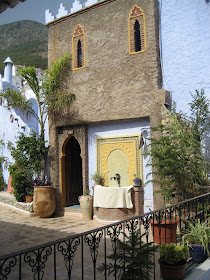Expats in Tangier bring their very personal style to their homes. They take what's best in each country they visit or live in, mix it with what they brought from their country of origin and give their own spin to the lot. The result is often spectacular, sometimes quirky and always original. Such is the case of this english couple who spend the summer months in Tangier.
The house sits in a large garden overlooking the sea and Spain beyond. Originally, it was a rather small house that was completely refurbished. Extensions were added as well as a swimming pool. The general atmosphere is continental but Moroccan touches remind one that we are indeed not in London anymore.
For proof, one needs only notice the contrast between the Union Jack cushion on the sofa and the modern painting of a touareg on his camel. Books on European and Moroccan decor, sites to see and cuisine are piled up on the coffee table.
The owner is an avid gardener who hates to see bare soil. The outdoor furniture has been painted a bright cheerful turquoise and flowers fill pots, planters and flower beds.
The antique family portrait and marble fireplace could be seen in a London house...
...but everywhere are reminders that those who live here travel extensively and in fact, just returned from India.
The drawing room is bright and colourful...
...and done in shades of turquoise and green, very Designer's Guild.
A pillow with a portrait of the young royal couple was given to the owner in jest but it gives the room quirkiness and originality and I hope they keep it there.
Altogether a comfortable, lovely home with a lot of England, some Morocco and a bit of everywhere else in the world, much like their life.












































